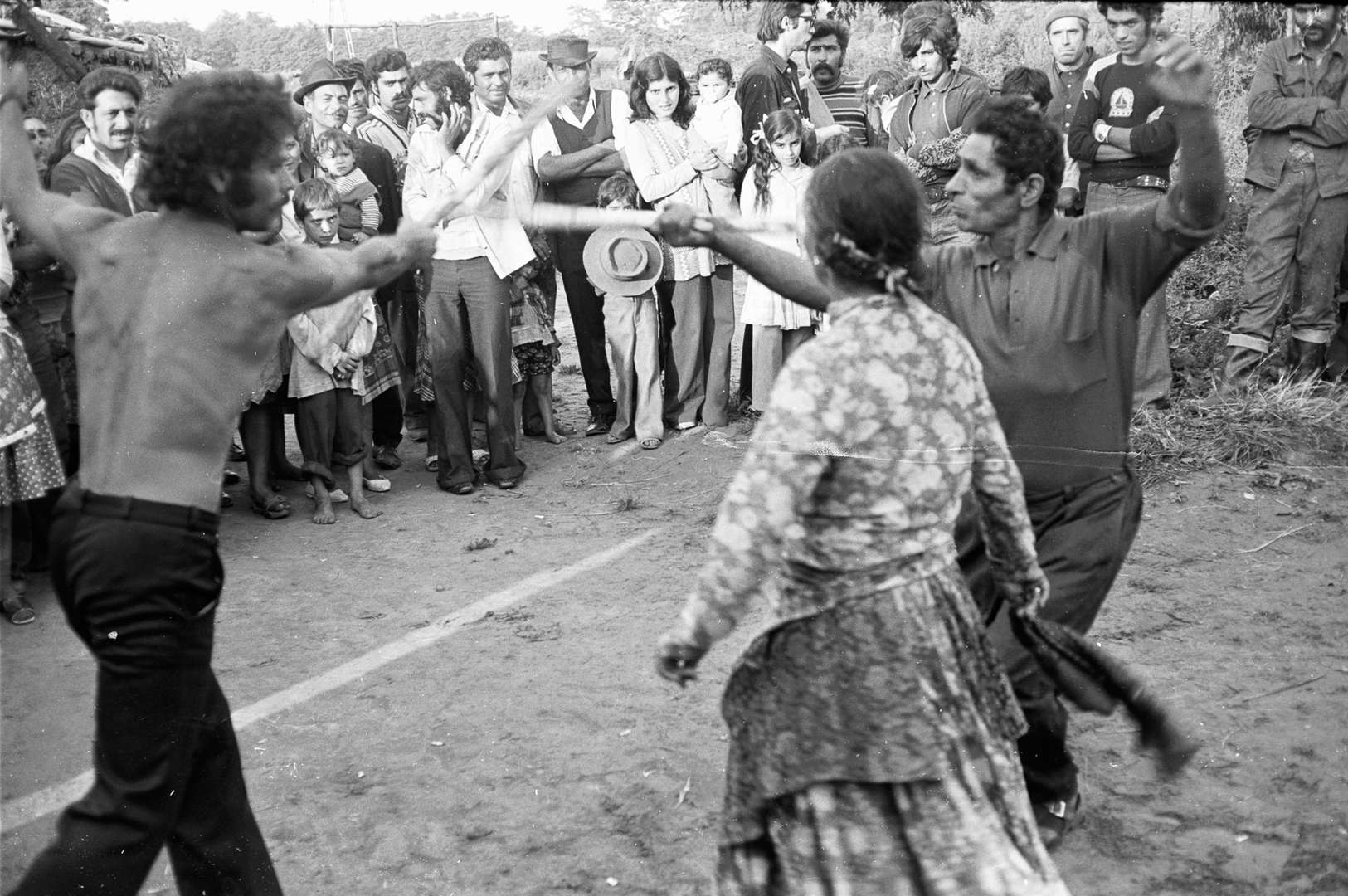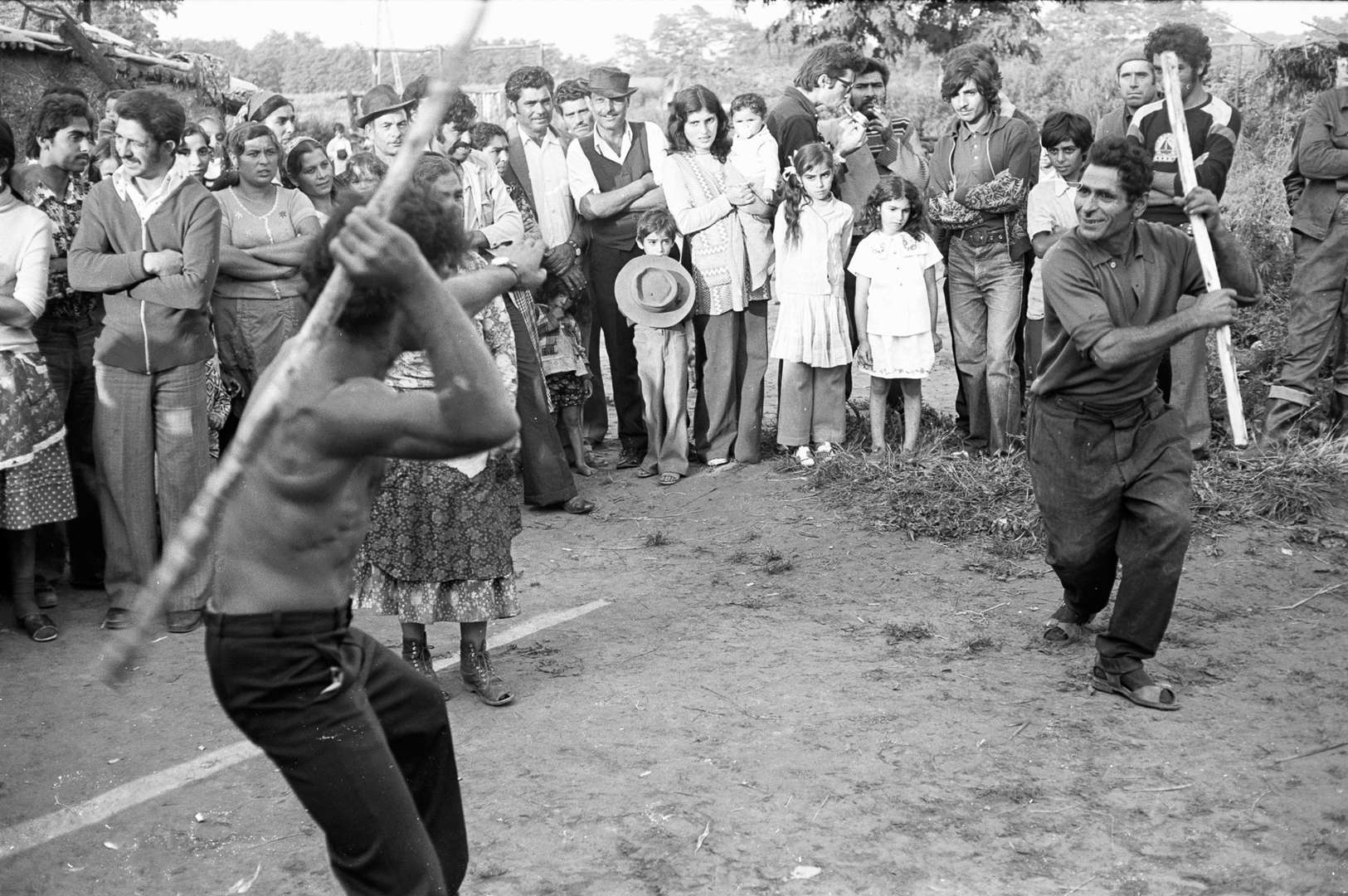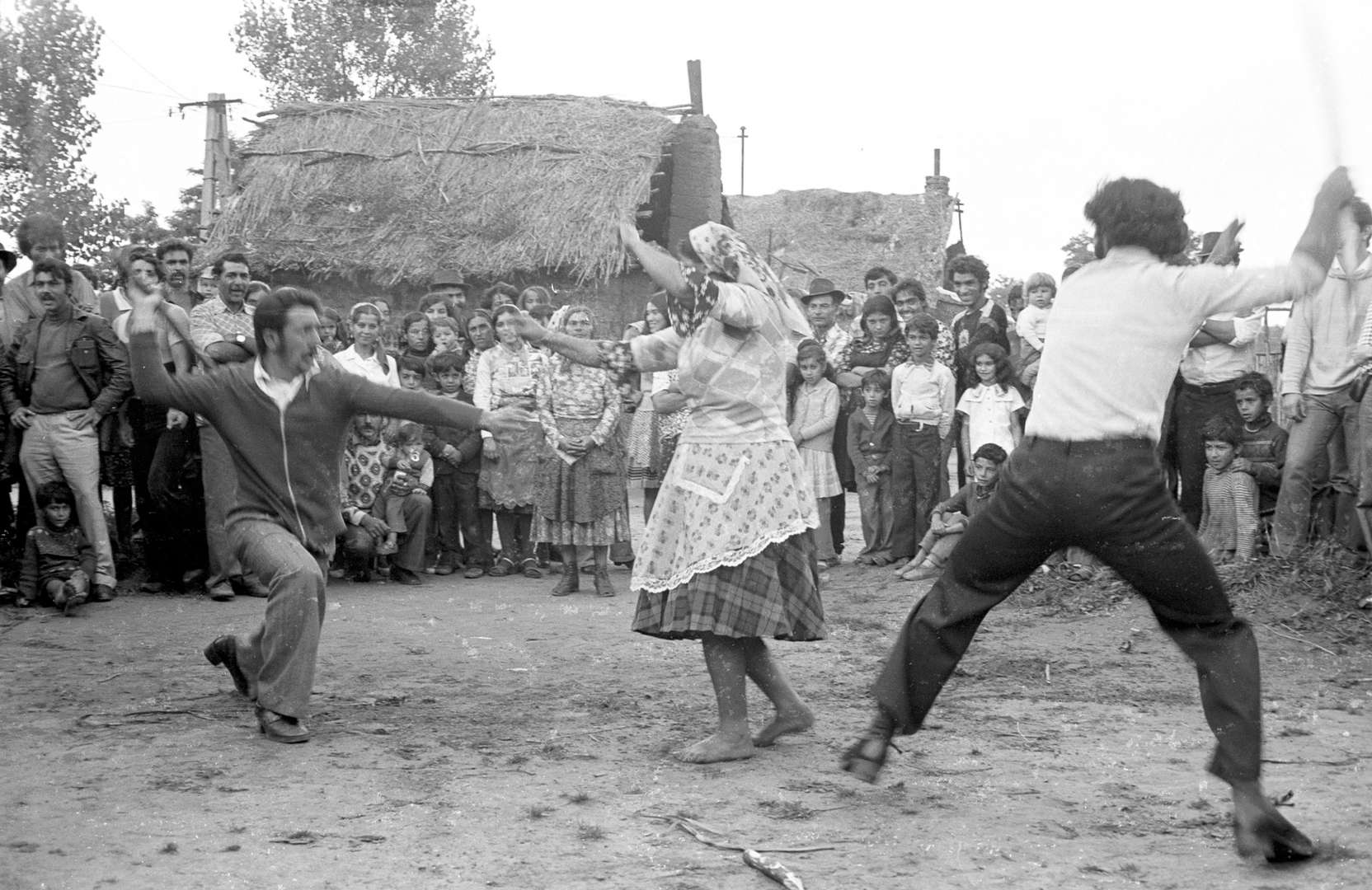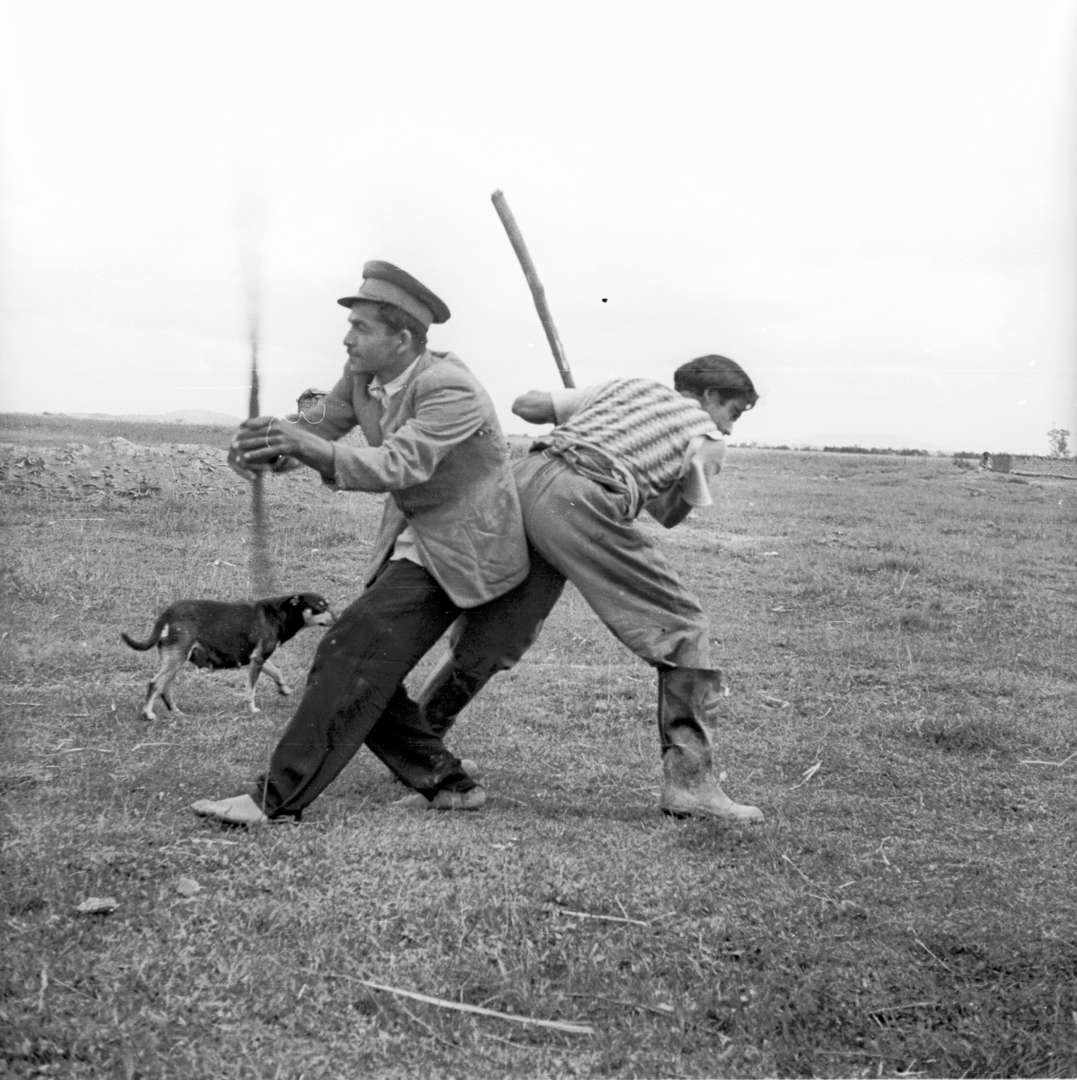Romani people in Hungary, also known as magyarországi romák, make up 3.8 per cent of the total population, according to the 2011 national census.1 Exactly when they entered the country is not clear but there are charters of references to people called Cigan, Cygan or Chygan or to villages named Zygan estimated to date from around the thirteenth or fourteenth century (Kemény, 2005).
Hungarian Dance Collection
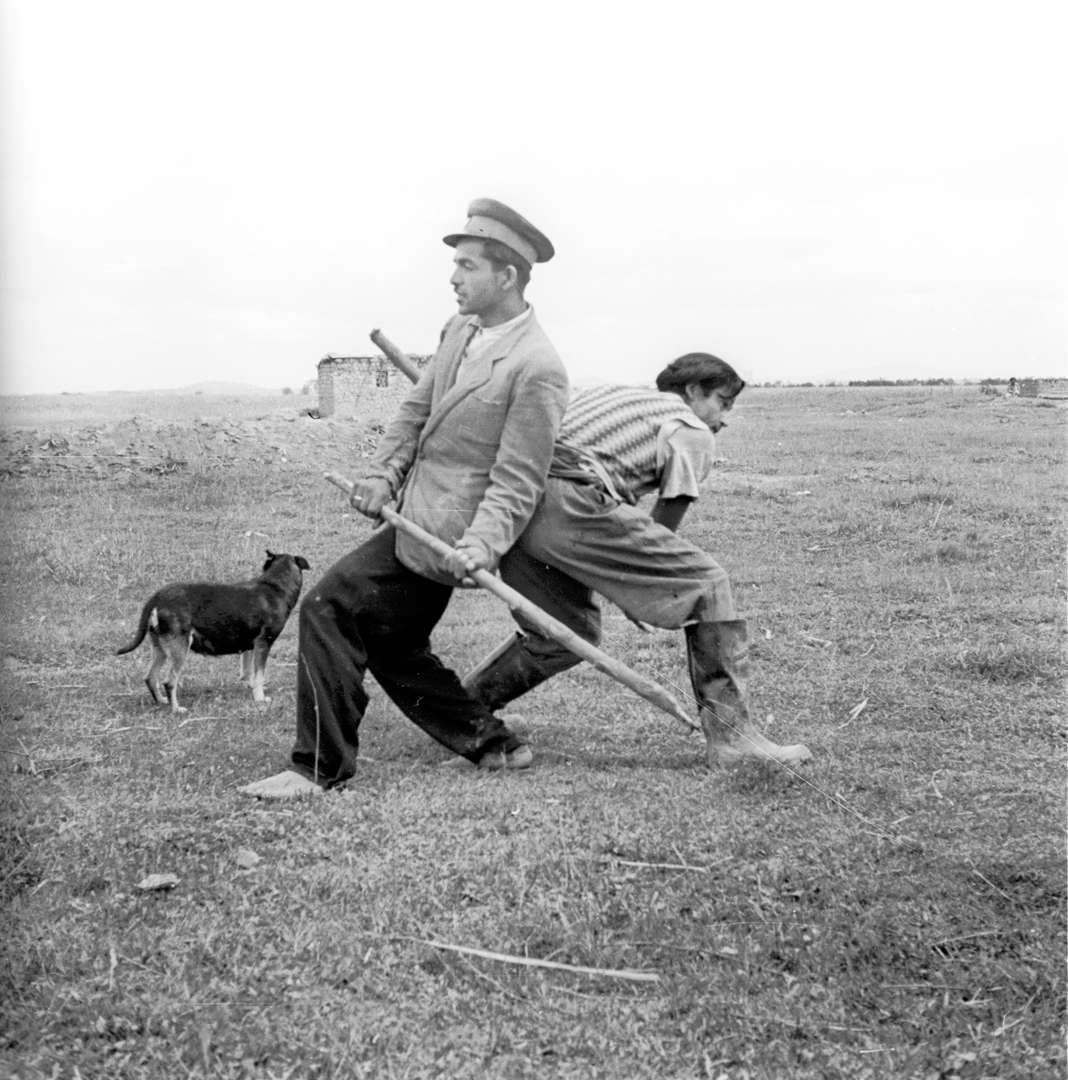

Zsuzsanna Bene | Botoló (Stick Dance) Tf.3823 | photography | Hungary | 1955 | dan_00072 Rights held by: Zsuzsanna Bene (artwork) / Research Centre for the Humanities – Hungarian Academy of Sciences (scan) | Licensed under: Rights of Use (scan) | Provided by: Research Centre for the Humanities – Hungarian Academy of Science (Budapest/Hungary)
Hungary Overview: Botoló and Czárdas
Katalin Kovalcsik (2003) deconstructs Roma music saying,
‘Traditionally there are two kinds of music performed by the Roma: one is musical service rendered for non-Romani audiences, the other is music made within the Romani community. The music played for outsiders is labelled “Gypsy music” by Hungarian scholarly literature, having adopted its colloquial name, while the music the Roma use among themselves is called “folk music”.’
She goes on to state that the term ‘Gypsy music’ was coined by the Hungarian composer Ferenc (Franz) Liszt. In his book published in French in Paris in 1859 and two years later in Hungarian in Pest – On Gypsies and Gypsy Music in Hungary (Liszt, 1959, 1861) – he referred to music played by professional Romani performers as ‘Gypsy music’.2
Weapon dances and war dances probably exist all over the world. Dances which use some type of weapon-like implement (sword, axe, hatchet, stick etc.) have been classified as weapon dances which reflect the times. The remains of antique dance culture of this kind is also found in Hungary, and references to dances like the Botoló (Stick Dance) are well known (Martin, 1979).
The Hungarian Academy of Sciences’ Photographic Archive has offered a collection which documents various versions of the Botoló both in a performance context and in rural environments. The collection comprises one hundred images dating from 1955 to 1989, and a number of shots capture the nuances of the dance. A second collection offered by the Special Collections Leeds University Library highlights ten colour etchings that were created by artist Ernö Barta. These showcase a Hungarian folk dance performed by men and women in traditional costumes. While we are not sure whether the dance is the well-known folk dance known as Czárdas, this section contextualises the dance.
Ernö Barta: Hungarian Etchings
Dance imagery and the manner in which the Roma art of dance is portrayed in the visual arts is important for the history of the Roma community. During the nineteenth and twentieth centuries, many artists created highly sophisticated works which can be seen around the world today. Among them is the Hungarian Ernö Barta (1878–1956), a graphic artist and painter who became active around the turn of the century. In the 1900s, he joined the Munich Art Nouveau Movement and in the 1920s created a series of prints that are held in the special collections at the Brotherton Library at the University of Leeds (UK).
These ten, wonderfully vivid etchings of Romani dances from festivals all over Hungary are called ‘Hungarian Dances’. The colours are intensely vibrant: vivid pinks, blues, oranges and greens successfully convey the atmosphere of the Roma festivities depicted. The etchings are all drawn mid-dance and as such they show a culture and its people at their most festive and joyous. These dances are not limited to the older generation either: there are also etchings of younger people partaking in these activities, showing a community united by the thrill of dance (Banatvala, 2017).
While the dances depicted in Barta’s etchings are not clearly specified it is important to contextualise ‘Hungarian Dances’.
‘In the nineteenth and twentieth centuries, composers – as representatives of Europe’s intellectual elite – actively shaped the topos of Gypsy music in European culture. Towards the end of the eighteenth century, a much faster dance began to be performed in pairs and was known under a series of names [...]. The dances themselves lacked a single unifying name, but by 1844 they began to be associated with the Czárdas (inn or hostelry) where they were typically performed.’
Pesovar 1987, p. 149
‘Like the Verbunkos, the Czárdas started to take on the significance of a national dance. As early as 1800, in the Allgemeine Musikalische Zeitung, Hungarian national dances were described as ‘either slow . . . suitably called recruitment dances, while the faster are referred to as Gypsy or folk.”’ Around 1835, Márk Rózsavölgyi (1789–1848), a violinist and respected composer of dance (including Verbunkos) [...] took steps towards creating a national Hungarian dance that would constitute an alternative to the foreign, chiefly German, dances preferred at gentry balls. Many popular musicians were involved in a similar process of transforming the Hungarian dance tradition, modelling the alternative, among other forms, on the then popular polonaise.’
Piotrowska, 2013
The Hungarian national dance, the Czárdas, is a courting dance performed by a couple. It has a slow section, the Lassú, which is followed by an exciting faster section known as the Friss. The dancers are instructed to carry themselves in an erect manner with a sense of pride. The Czárdas includes fast footwork where the dancers snap their feet inward and outward, while the couples whirl. The music, often played by a Roma orchestra, is in 2/4 or 4/4 time with compelling, syncopated rhythms.
The Czárdas developed in the nineteenth century from an earlier folk dance, the magyar kör (see Encyclopedia Britannica online czardas and folk dance). The Hungarian composer Franz Liszt wrote music that was reminiscent of the Czárda in his Hungarian Rhapsodies. Kovalcsik (2003) reminds us that the mushrooming of ‘Gypsy’ bands in the last decades of the eighteenth century was triggered by the Hungarian nationalist movement, which encompassed all cultural genres, including neology, music, dance and costumes.
The University of Leeds makes a distinction between the Gypsy, Traveller and Roma community and have separate collections that reference a variety of ethnic (eg Romany/Irish Traveller) and non-ethnic communities (eg New Traveller) with a nomadic culture, history or lifestyle.
For further information please visit: Library Leeds

The collections contain a large number of published works including many pieces that were donated in the 1950s by the niece-in-law of Lord Brotherton, Dorothy Una Ratcliffe. Ratcliffe was fascinated by Romani culture; she spent much of her life writing about the Roma and collecting photographs and publications about their culture both at home and abroad.
Hungarian Dance Songs
The Hungarian Roma repertoire includes a type of music that could be considered ‘Dance Songs’ which as the name says, serve to accompany dances. Kovalcsik (2003) describes their typical features:
‘They are in duple time, the text lines are seven- or eight-syllabic but they may acquire three syllables in the middle and at the end of the tune, e.g. 8, 8+3, 8, 8+3, or the number of lines may increase, e.g. to six: 8, 8, 8+3, 8, 8, 8+3, etc.’ (Sárosi 1978: 27)
The Botoló (Stick dance) is in triple meter 3/8 or 6/8 and can include some strophes which combine duple and triple time.
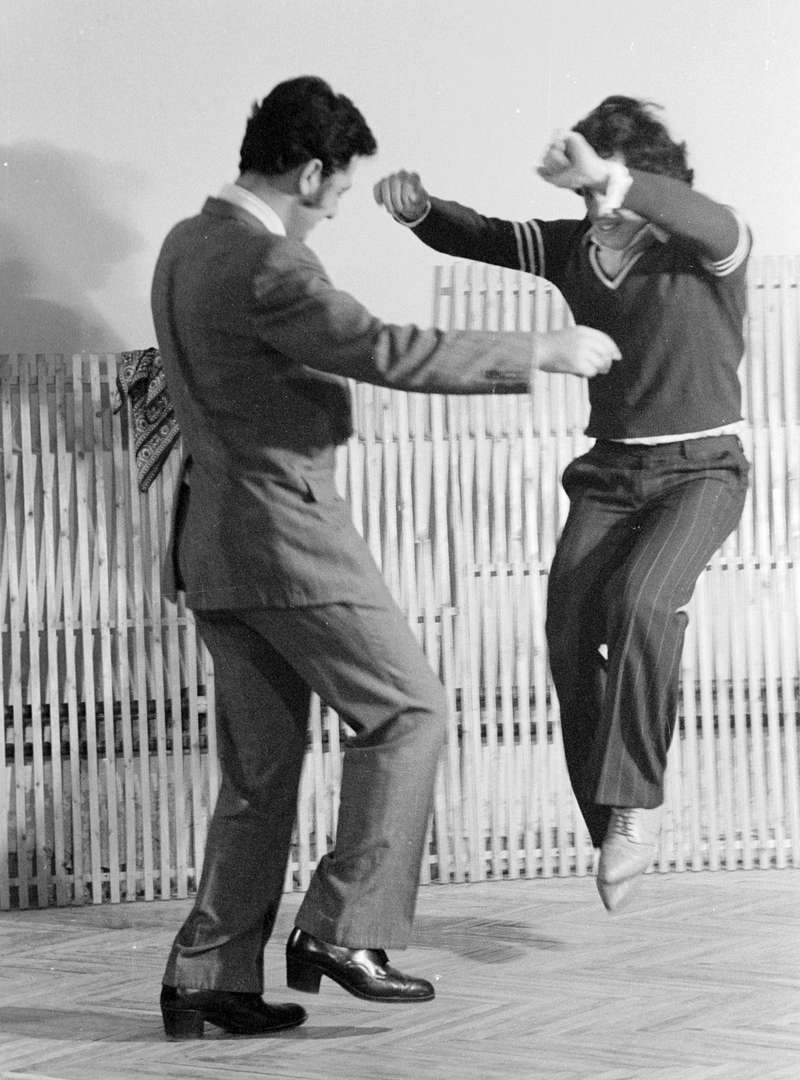
Cigánytánc 1981
Rights held by: Ernő Pesovár (artwork) / Research Centre for the Humanities – Hungarian Academy of Science (scan) | Licensed under: Rights of Use (scan) | Provided by: Research Centre for the Humanities – Hungarian Academy of Science (Budapest/Hungary)Stick Dance
The first dance to emerge from Hungarian historical source material is the sixteenth- and seventeenth-century Heyduck dance. This dance has been interpreted as a shepherd – soldiers’ weapon dance, but in a wider sense it also represents the general folk dance style of the period. According to the historical accounts, male dancers, both alone and in groups, performed acrobatic configurations virtuostically whirling their weapons, and combining free-form compositions (Martin 1979: 8). The handling of the weapon is reminiscent of combative, fencing movements and could be performed by male groups or in pairs which included women. The dance includes forceful, acrobatic stamps and charismatic gestures of the arms and rhythmical shouts. The popular instruments of the era such as the bagpipes (tárogató), fiddles or the drum were also part of this Hungarian Dance Song style.
Among the numerous Eastern European instrumental weapon dances, the Stick Dance merits the most attention.
‘The stick dances of those shepherds and gypsies dwelling in the countryside that borders the Great Plain to the north-east represent the richest and most integral of Eastern European weapon dances.’ (Martin, 1979)
Martin also explains that for two or three decades the best stick dancers emerged from among the Bereg, Szatmdr, Nyirsdg half-breed ‘shepherd-gypsies’ as well as the coppersmith bell pourers and the trough scoopers. The Botoló dances of the north-eastern region of the Great Plains (mainly the Szatmár region) and the Kanásztánc (Swineherdsmen's Dance) of Transdanubia (mainly the Somogy region) are living proof of the wild Heyduck dances of old times.
Rights held by: Rosamaria E. Kostic Cisneros | Licensed by: Rosamaria E. Kostic Cisneros | Licensed under: CC-BY-NC 3.0 Germany | Provided by: RomArchive





